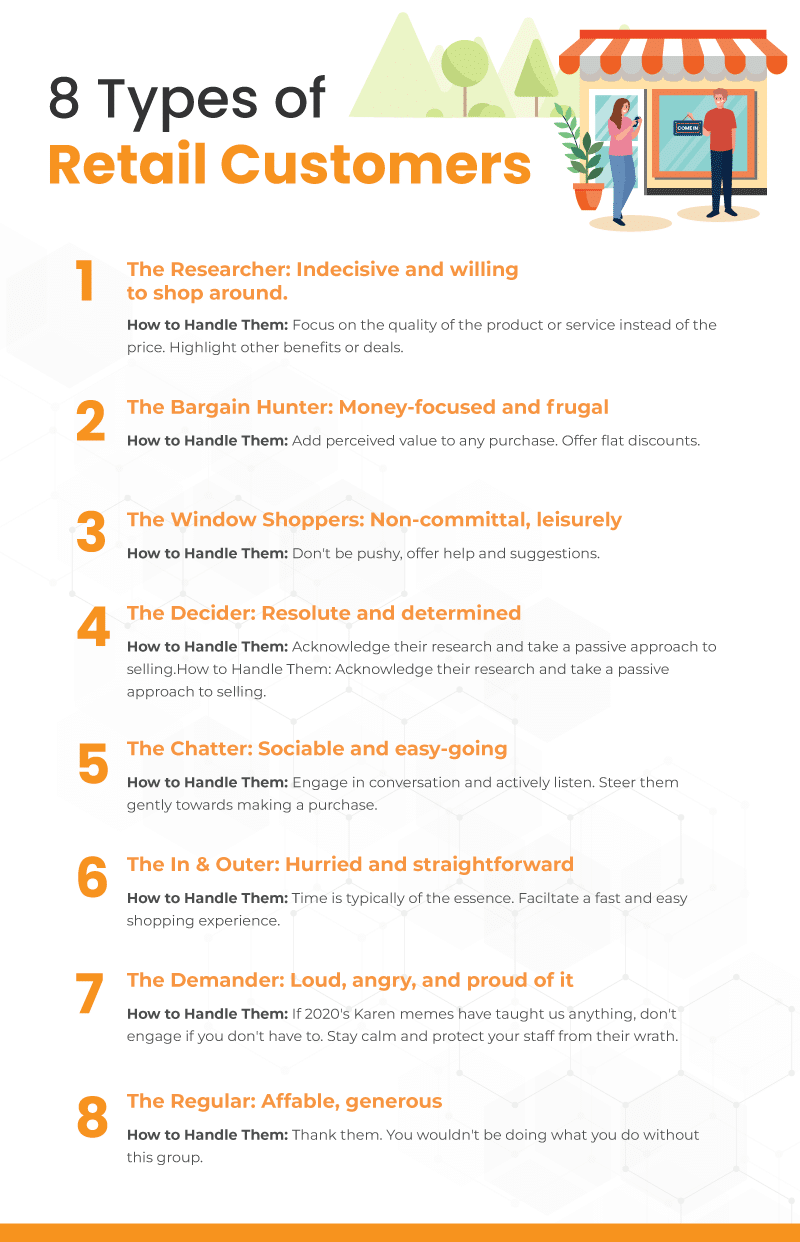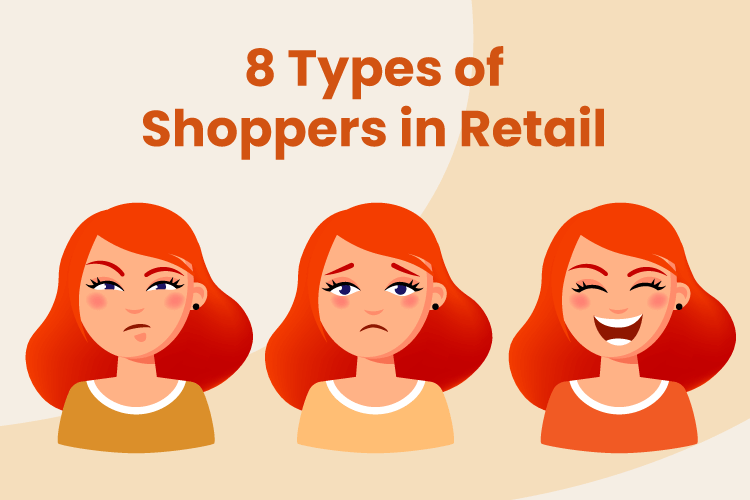Part of the fun of owning or managing a retail store is getting to interact with a diverse array of people all day. Studies show that 87% of retail purchases are made in-store. From the decisive, in-and-out shopper to the one that will tell you their life story, there are many different types of customers in retail. And it’s your job to make the experience in your store great for each of them.
That means you must be able to quickly recognize the type of shopper they are, and also know how to handle and approach each customer appropriately. Check out the following list for some identifiers and some tips on how to appease them. Let us know about any others we might be missing here!

1. The Researcher or Showroomer
Showrooming is a newer retail term and a growing trend among consumers. They still appreciate brick and mortar shopping but will make the final purchase online if it’s cheaper. You can typically identify these shoppers by keeping an eye out for people using price comparison apps or scanners.
Similar to those crazy Black Friday deals we discussed recently, big box retailers can afford to simply match the lowest price a customer finds online. While this might be nice for consumers who are only concerned about the price, it’s not a possible solution for many small and medium-sized retail stores.
How to Deal: Instead, you should try to highlight the value and quality of the product or experience rather than the price. For instance, online prices might be cheaper but that’s not accounting for delivery. Plus, delivered products may take days or weeks to arrive, whereas purchasing in-store is immediate gratification.
You might also consider highlighting tangential in-store offers, like your great loyalty program or warranty policies. Just try to find ways to justify spending a little more than they would online. Employing great retail sales experts can also help you convert more sales from this type of customer. With the right approach, you can even make showrooming beneficial.
2. The Deal Seeker or Bargain Hunter
This type of shopper is similar to showroomers but typically more focused on saving money in general, rather than on a specific product. Researchers know what type of product they want already; they just would like to see it in person prior to purchasing. Deal seekers are more open to persuasion and impulse buys.
That’s not to say that deal seekers are always easy to deal with. They might be the most likely type of customer to haggle on your pricing, or openly complain about how expensive a certain product is.
How to Deal: To best handle your average bargain hunter, find ways to add perceived value to the entire experience. Point out any promotions or deals. Offering flat discounts if they spend a certain amount can also be a great tactic. If you play it right, you may even get them to spend more than they ever planned. It just depends on how good you are at marketing your discounts.
3. The Window Shopping Wanderer
Many consumers still simply enjoy shopping for shopping’s sake. They may not be intending to purchase anything, but that doesn’t mean you shouldn’t try to push them toward making a purchase.
How to Deal: Approach these customers with care. Don’t ever come across as pushy or salesy. Greet them, mention any specials, make them feel welcome, and offer your help if they have any questions. Coming off as too concerned with making a sale might annoy or intimidate them and send them quickly packing.
You might also consider making changes to the physical layout of your retail space. It’s always important to play around with your in-store merchandising, including your POS marketing area, window displays, shelving, and product placement. Small changes can make a big difference with this type of shopper.

4. The Decisive, Take Charge Type
Know-it-alls already know what they want. They’ve either made their decision before they enter your store, or have done enough research that they are debating between two or three very similar products. Access to information and online reviews have changed modern shopping, allowing many consumers to become this type of customer. They often look carefully at product descriptions, sourcing, prices, and reviews.
How to Deal: One solution is to make your presence known well before they even step foot in your store. This can only be done by improving your web presence.
- Keep your store up to date with accurate details on all major reviews sites. Publicly address negative reviews and trolls.
- Stay active on your social media channels – more and more consumer decisions are based on social media influences.
- Update your website performance. It must be fast, but also easy to navigate and intuitive. Be sure it’s optimized for mobile users, too.
Once this customer is in your store, take a more passive approach to selling. Acknowledge that they have done their research and look for a way to make them feel important and cared for. They are most interested in the overall value of the product and the customer experience as a whole, not just the price.
Don’t give too much advice, and NEVER suggest an alternative option. This might stress them out and lead them to not make the purchase. Often, they simply seek confirmation that their hunch was the right one.
5. The Sociable Chatter
This type of shopper is great to have around! They’re friendly and interested in your store, even if they may talk a little bit too much. As a retail business owner, you might have to listen to a few boring stories, but there are worse things you could be forced to deal with.
How to Deal: If you have time, listen. Work on being an active listener, which is a great skill for a retail sales associate. You never want the customer to know they’re boring you! Offer them signs of affirmation and show them you care.
If you don’t have time, or notice other customers are waiting for your attention, find a way to politely diffuse the situation and move on. It’s ok to even remind them that there are other customers waiting. It’s easy for people to tell if you’re reaching for a made-up excuse. Honesty is always the best policy.
6. The In & Out Sure Buyer
Similar to the decisive type, the sure buyer actually already has their mind made up. They are on a mission to be in and out of your store in record time. And to be fair, most of us are pretty busy! It’s important that your customers know coming to your store doesn’t always have to take a large chunk of time if they don’t have it.
How to Deal: Stay out of their way as much as possible. If they have brief questions, offer short, straightforward answers. Don’t bother trying to sell anything else to them.
You can also change your checkout system. It might be smart to get a few backup registers, particularly point of sale tablets that are compatible with your POS system. Make sure all your staff is trained on your system so that anyone can help out if there is a long line.
Offering purchase online pickup in-store is another great way to appease these rushed shoppers. This also keeps lines shorter for all of your other shoppers, who will appreciate it even if they aren’t in a rush. Maintaining a fast retail checkout is of the utmost importance during the holiday season.
7. The Angry, Demanding Pessimist
Let’s face it, this type of customer can seem impossible to handle. But they do exist, and you’re bound to run into them eventually. Valid complaints are easy to deal with: you just take care of the problem in whatever you see fit, and the customer is satisfied. But there will be the irrational shopper who is looking for reasons to be upset.
How to Deal: It’s important to be understanding, listen well, and stay calm. Try your best not to show any emotion at all, as hard as that might be. Ask them what they think would be a fair solution. Offer the best solution you see fit. Don’t feel obligated to go above and beyond. This type of consumer is often looking to force deals, or even trying to steal from you.

8. The Regular
Your regulars brighten every day. They are what makes your retail store successful. Find ways to spoil them and show how much you appreciate their business and loyalty.
How to Deal: Offering a generous loyalty program is a great way to start. It incentivizes frequent visits. Try hosting invite-only store events. This is easy for people running bookstores, wine shops, bakeries and coffee shops, or even boutique retailers.
Even giving away small items or discounts can be worth it. Gifts are a great way of making your regulars feel special without taking away a portion of a sale that would have been made anyway. And using this policy toward new customers, too, can make new regulars for your store.
Responding To Different Types Of Retail Customers
So what type of customer does your store tend to attract? Do you have a large regular base? Or are you more of a quick service, in-and-out destination? For different retail niches, one of these customer types might be more common than others. It’s important to identify which you’re most likely to see, and how you might increase sales by appealing to these types in a better way.
It might mean a different avenue for your marketing strategies, more staff training, or a redesign of your store. Either way, it’s always important to stay active in improving your store in every way possible. For more retail advice, subscribe to the blog! And for a great point of sale solution, tap the button below to find out more about KORONA POS.












